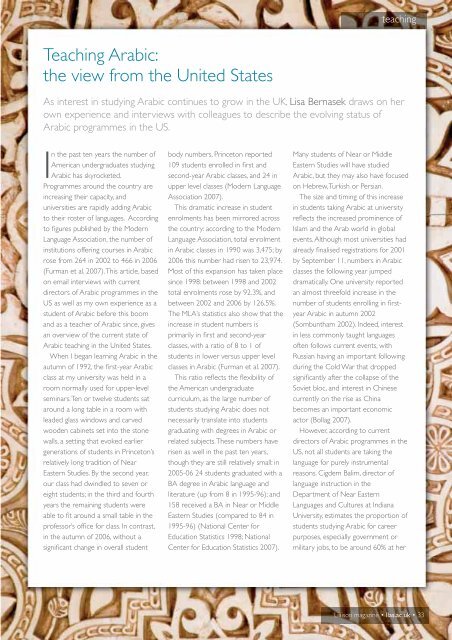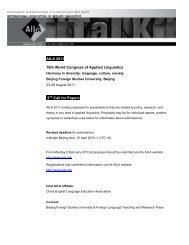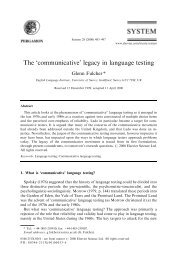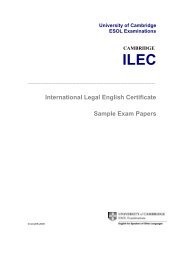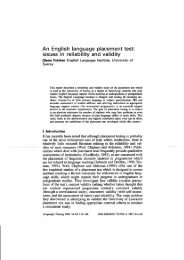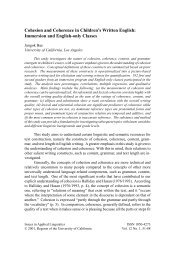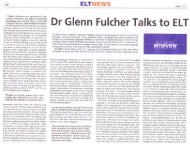Liaison Magazine - LLAS Centre for Languages, Linguistics and ...
Liaison Magazine - LLAS Centre for Languages, Linguistics and ...
Liaison Magazine - LLAS Centre for Languages, Linguistics and ...
You also want an ePaper? Increase the reach of your titles
YUMPU automatically turns print PDFs into web optimized ePapers that Google loves.
teaching<br />
Teaching Arabic:<br />
the view from the United States<br />
As interest in studying Arabic continues to grow in the UK, Lisa Bernasek draws on her<br />
own experience <strong>and</strong> interviews with colleagues to describe the evolving status of<br />
Arabic programmes in the US.<br />
In the past ten years the number of<br />
American undergraduates studying<br />
Arabic has skyrocketed.<br />
Programmes around the country are<br />
increasing their capacity, <strong>and</strong><br />
universities are rapidly adding Arabic<br />
to their roster of languages. According<br />
to figures published by the Modern<br />
Language Association, the number of<br />
institutions offering courses in Arabic<br />
rose from 264 in 2002 to 466 in 2006<br />
(Furman et al. 2007).This article, based<br />
on email interviews with current<br />
directors of Arabic programmes in the<br />
US as well as my own experience as a<br />
student of Arabic be<strong>for</strong>e this boom<br />
<strong>and</strong> as a teacher of Arabic since, gives<br />
an overview of the current state of<br />
Arabic teaching in the United States.<br />
When I began learning Arabic in the<br />
autumn of 1992, the first-year Arabic<br />
class at my university was held in a<br />
room normally used <strong>for</strong> upper-level<br />
seminars.Ten or twelve students sat<br />
around a long table in a room with<br />
leaded glass windows <strong>and</strong> carved<br />
wooden cabinets set into the stone<br />
walls, a setting that evoked earlier<br />
generations of students in Princeton’s<br />
relatively long tradition of Near<br />
Eastern Studies. By the second year,<br />
our class had dwindled to seven or<br />
eight students; in the third <strong>and</strong> fourth<br />
years the remaining students were<br />
able to fit around a small table in the<br />
professor’s office <strong>for</strong> class. In contrast,<br />
in the autumn of 2006, without a<br />
significant change in overall student<br />
body numbers, Princeton reported<br />
109 students enrolled in first <strong>and</strong><br />
second-year Arabic classes, <strong>and</strong> 24 in<br />
upper level classes (Modern Language<br />
Association 2007).<br />
This dramatic increase in student<br />
enrolments has been mirrored across<br />
the country: according to the Modern<br />
Language Association, total enrolment<br />
in Arabic classes in 1990 was 3,475; by<br />
2006 this number had risen to 23,974.<br />
Most of this expansion has taken place<br />
since 1998: between 1998 <strong>and</strong> 2002<br />
total enrolments rose by 92.3%, <strong>and</strong><br />
between 2002 <strong>and</strong> 2006 by 126.5%.<br />
The MLA’s statistics also show that the<br />
increase in student numbers is<br />
primarily in first <strong>and</strong> second-year<br />
classes, with a ratio of 8 to 1 of<br />
students in lower versus upper level<br />
classes in Arabic (Furman et al. 2007).<br />
This ratio reflects the flexibility of<br />
the American undergraduate<br />
curriculum, as the large number of<br />
students studying Arabic does not<br />
necessarily translate into students<br />
graduating with degrees in Arabic or<br />
related subjects.These numbers have<br />
risen as well in the past ten years,<br />
though they are still relatively small: in<br />
2005-06 24 students graduated with a<br />
BA degree in Arabic language <strong>and</strong><br />
literature (up from 8 in 1995-96); <strong>and</strong><br />
158 received a BA in Near or Middle<br />
Eastern Studies (compared to 84 in<br />
1995-96) (National Center <strong>for</strong><br />
Education Statistics 1998; National<br />
Center <strong>for</strong> Education Statistics 2007).<br />
Many students of Near or Middle<br />
Eastern Studies will have studied<br />
Arabic, but they may also have focused<br />
on Hebrew,Turkish or Persian.<br />
The size <strong>and</strong> timing of this increase<br />
in students taking Arabic at university<br />
reflects the increased prominence of<br />
Islam <strong>and</strong> the Arab world in global<br />
events. Although most universities had<br />
already finalised registrations <strong>for</strong> 2001<br />
by September 11, numbers in Arabic<br />
classes the following year jumped<br />
dramatically. One university reported<br />
an almost threefold increase in the<br />
number of students enrolling in firstyear<br />
Arabic in autumn 2002<br />
(Sombuntham 2002). Indeed, interest<br />
in less commonly taught languages<br />
often follows current events, with<br />
Russian having an important following<br />
during the Cold War that dropped<br />
significantly after the collapse of the<br />
Soviet bloc, <strong>and</strong> interest in Chinese<br />
currently on the rise as China<br />
becomes an important economic<br />
actor (Bollag 2007).<br />
However, according to current<br />
directors of Arabic programmes in the<br />
US, not all students are taking the<br />
language <strong>for</strong> purely instrumental<br />
reasons. Cigdem Balim, director of<br />
language instruction in the<br />
Department of Near Eastern<br />
<strong>Languages</strong> <strong>and</strong> Cultures at Indiana<br />
University, estimates the proportion of<br />
students studying Arabic <strong>for</strong> career<br />
purposes, especially government or<br />
military jobs, to be around 60% at her<br />
<strong>Liaison</strong> magazine • llas.ac.uk •33


